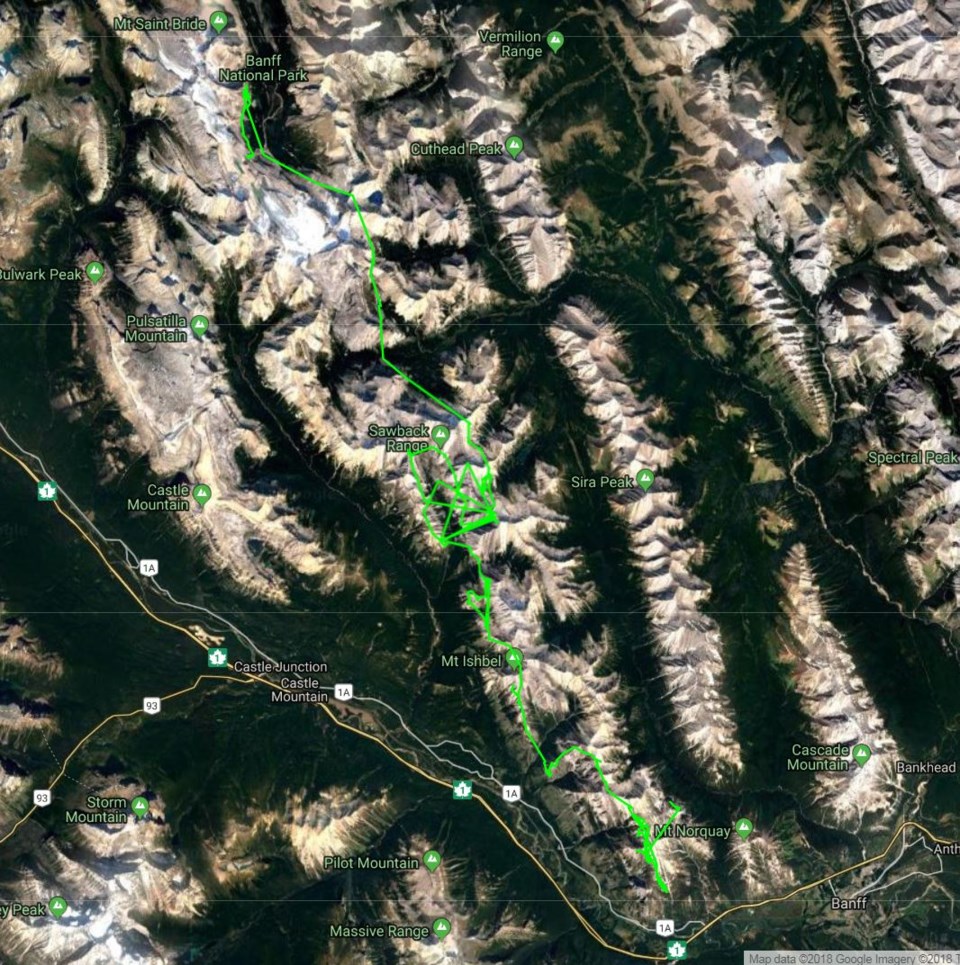LAKE LOUISE – A big trek by a lone collared mountain goat caught the attention of Parks Canada researchers.
Data from a GPS collar on one of 10 goats collared in the Slate Range near the Lake Louise ski resort shows a young male goat booked it for about 50 kilometres from the Skoki-Baker Creek area to Mount Cory near Banff in less than a week.
“It kind of took off on this journey in July, moving fairly quickly,” said Jon Stuart-Smith, a wildlife management specialist in Lake Louise, Yoho and Kootenay. “Since then it’s moved to the Sawback Range north of Mystic Pass and stayed there.”
Mountain goats are expert rock climbers and superbly adapted to a mountainous and snowy environments. They spend much of the year at or near the alpine, rarely venturing to lower elevations except to visit salt or mineral licks.
Some of the other collared mountain goats in the study have travelled about 20 kilometres across valleys, but none as far as this male mountain goat or in such a short time frame.
Stuart-Smith said most collared mountain goats have returned to the area where they were initially captured and collared, but this male goat hasn’t returned.
“Males do disperse periodically, especially in mating season, but mating season isn’t in July,” said Stuart-Smith.
“It could be dispersing from a population standpoint, looking for new territory or new mates or new food.”
While researchers find this interesting, Stuart-Smith can’t say for sure if this lengthy traverse is out of the norm for goats in this area.
“It’s something we’re hoping to better understand as the study evolves,” he said.
With mountain goats declining throughout their historical range in western Canada, this study aims to better understand goat habitat use and movement patterns, as well as use of mineral licks where animals go to lick essential nutrients.
Goat numbers and distribution has declined in the Slate Range over the past 35 to 40 years, with general consensus that goat use in the area of the ski hill appears to have declined in conjunction with past expansion of ski area activities.
Lake Louise ski hill, which has major development plans for new ski lifts, new ski terrain and construction of new lodges, has kicked in funding for the 10 collars, which cost about $2,000 each.
In neighbouring Yoho, Parks Canada is watching goat use of mineral licks at the Lake O’Hara turnoff and Sherbrooke Creek to make sure goats aren’t negatively affected by the Trans-Canada Highway twinning project.
Researchers also want to learn more on where mountain goats travel in the area, including where they cross the Trans-Canada Highway and how they’re moving between mountain ranges.
Meanwhile, none of the 10 collared mountain goats in Banff National Park have died, though two of the 10 in Yoho met their death – both perhaps killed and eaten by grizzly bears.
The scant remains of a mountain goat were discovered just below treeline near Sherbrooke Lake in the eastern end of Yoho last month. While the bear ate the goat, it can’t be 100 per cent confirmed if it scavenged the carcass or actually killed the animal.
There’s also a possibility another mountain goat was killed by a grizzly bear in spring, but once again, Parks Canada couldn’t say for sure whether the goat was scavenged or preyed upon.




